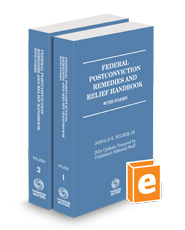Federal Postconviction Remedies and Relief Handbook covers all nine federal postconviction remedies:
- The petition for a writ of habeas corpus, available to federal convicts under 28 U.S.C.A. § 2241
- The motion to vacate, available to federal convicts under 28 U.S.C.A. § 2255
- The petition for a writ of habeas corpus, available to state convicts under 28 U.S.C.A. § 2254
- The motion in the nature of coram nobis, available to federal convicts under 28 U.S.C.A. § 1651
- The motion to correct sentence, available to federal convicts under Federal Criminal Rule 35(a)
- The motion to reduce sentence, available to federal convicts under 18 U.S.C.A. § 3582(c)(2)
- The motion to correct clerical error, available to federal convicts under Federal Criminal Rule 36
- The civil action in the nature of mandamus, available to federal convicts under 28 U.S.C.A. §1361
- The motion for new trial or resentencing, available to federal convicts under the Federal Postconviction DNA Testing Statute, 18 U.S.C.A. § 3600
The handbook also covers:
- The two federal postconviction remedies for federal convicts which are available only if they are applied for by a prosecutor or a prison official
- The Federal Erroneous Convictions Act, under which, in certain circumstances, innocent persons convicted in federal court may obtain monetary compensation from the government
- The motion for a new trial based on newly discovered evidence, available to federal convicts under Federal Criminal Rule 33
- The motion to withdraw a plea of guilty or nolo contendere, available to federal convicts under Federal Criminal Rule 11
The Author's Comments are a key part of this handbook. They furnish an overview of and valuable background information about the federal statutes or rules included in the handbook.

